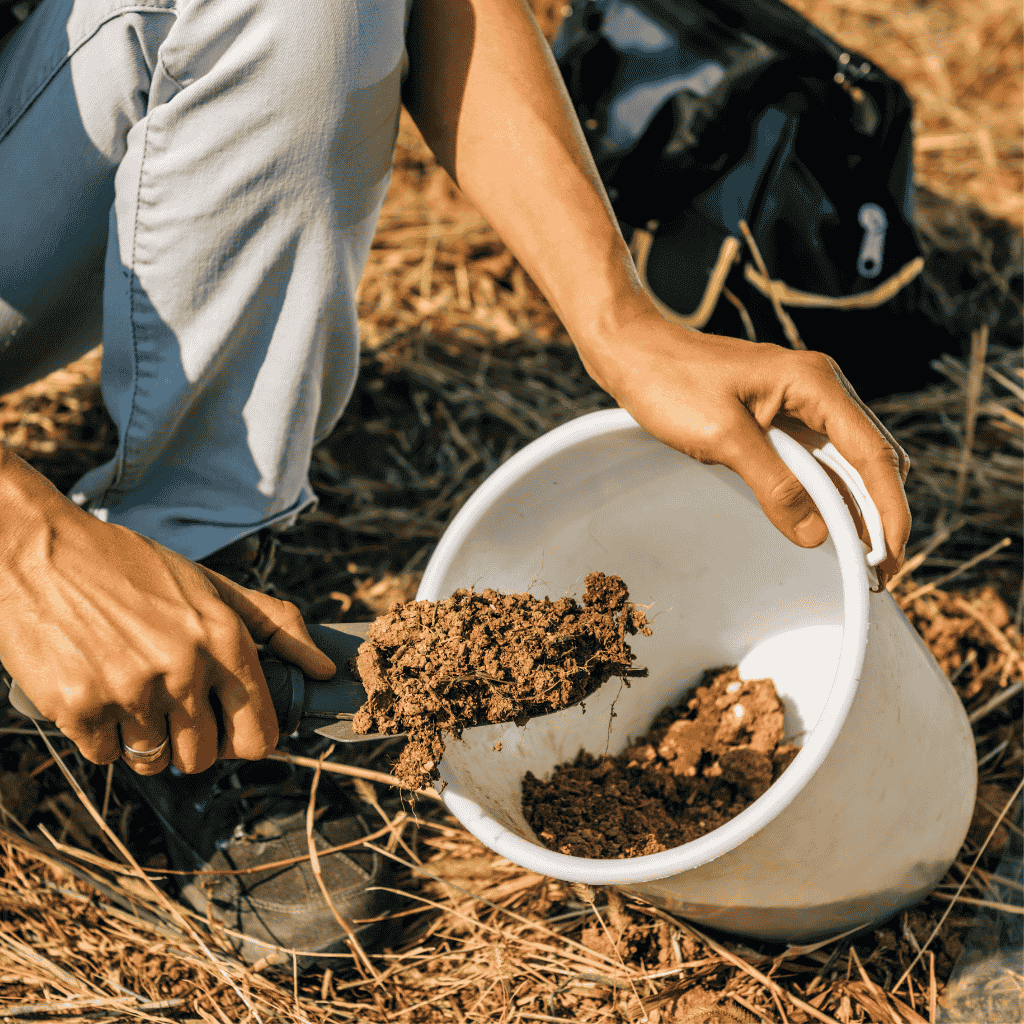

SOIL ANALYSIS
Through a comprehensive evaluation of 14 essential elements, it scientifically interprets your soil’s nutrient reserves—from macro elements like carbon, nitrogen, phosphorus,
and potassium to microelements such as zinc, boron, and molybdenum.
Accurate Insights, Stronger Yield
Through a comprehensive evaluation of 14 essential elements, it scientifically interprets your soil’s nutrient reserves—from macro elements like carbon, nitrogen, phosphorus,
and potassium to microelements such as zinc, boron, and molybdenum.
Traditional Method
- Only measures the total content of elements.
- Does not assess soil biological activity or overall health.
- Cannot determine nutrient availability for plants.
- Provides limited data, failing to reveal the soil’s full potential.
- Requires grinding soil into particles smaller than 2mm and drying it, disrupting its natural structure.
- Extracts nutrients through chemical methods that do not fully reflect real soil conditions.
Soliv Soil Analysis
- Assesses soil fertility.
- Measures the microbial activity and biological health of the soil.
- Analyzes the current status of essential nutrients such as organic nitrogen and phosphorus.
- Examines the water-soluble fractions of soil carbon.
- Uses H3A and H2O extraction to mimic plant roots, dissolve nutrients, and analyze organic nitrogen, phosphorus, and carbon.
- Evaluates microbial respiration and enzymatic activity.
- Analyzes the bioavailability of nutrients such as nitrogen, phosphorus, and carbon.
- Provides in-depth insights into the soil’s nutrient cycle, biology, and potential.
Traditional Method
- Only measures the total content of elements.
- Does not assess soil biological activity or overall health.
- Cannot determine nutrient availability for plants.
- Provides limited data, failing to reveal the soil’s full potential.
- Requires grinding soil into particles smaller than 2mm and drying it, disrupting its natural structure.
- Extracts nutrients through chemical methods that do not fully reflect real soil conditions.
Soliv Soil Analysis
- Assesses soil fertility.
- Measures the microbial activity and biological health of the soil.
- Analyzes the current status of essential nutrients such as organic nitrogen and phosphorus.
- Examines the water-soluble fractions of soil carbon.
- Uses H3A and H2O extraction to mimic plant roots, dissolve nutrients, and analyze organic nitrogen, phosphorus, and carbon.
- Evaluates microbial respiration and enzymatic activity.
- Analyzes the bioavailability of nutrients such as nitrogen, phosphorus, and carbon.
- Provides in-depth insights into the soil’s nutrient cycle, biology, and potential.
Discover Our Soil Analysis Packages!
Soil Health Test
Provides a comprehensive evaluation of soil’s biological and chemical processes, helping you understand overall soil health.
- Soil Respiration
- Organic Carbon & Nitrogen
- Microbial Active Carbon
- Carbon / Nitrogen Ratio
- Soil Health Score
- Cover Crop Recommendation
Total Nutrient Digestion Test
Utilizes next-generation extraction technology to deeply analyze the elemental reserves in your soil.
- Accurately determines soil nutrient reserves and potential.
- Provides long-term insights with a single analysis.
Let's Talk - Share Your Contact Information!

Benefits of Soil Analysis
-
Unlock Soil Potential:
Identifies nutrient levels and their availability. -
Precision Fertilization:
Prevents overuse or deficiency, ensuring cost savings. -
Sustainable Agriculture:
Maintains the biological and chemical balance of the soil. -
Increased Yield & Quality:
Provides plants with the right nutrients for optimal growth. -
Eco-Friendly:
Reduces unnecessary fertilization, protecting the environment. -
Investment in the Future:
Supports long-term soil health and productivity. -
Data-Driven Decisions:
Offers reliable insights for fertilization and irrigation. -
Resource Efficiency:
Optimizes costs and conserves natural resources. -
Soil Assessment:
Evaluates the biological and chemical composition of the soil.

What is a Soil Analysis?
Soil analysis is the process of determining the nutrient content, pH level, organic matter percentage, and other chemical, physical, and biological properties of soil in fields, gardens and orchards. The purpose of soil testing and analysis is to improve soil fertility, create a scientific foundation for precise fertilization, and enhance agricultural productivity. Even a basic soil analysis can provide critical insights into soil health and nutrient availability.

How to Do Soil Analysis?
Soil analysis is performed by collecting a properly taken soil sample and analyzing it in a soil analysis laboratory using modern equipment. First, a soil sample is collected from a specific depth and sent to the lab. Using advanced soil analysis equipment, key elements such as organic matter, nitrogen, phosphorus, potassium, and pH levels are measured. The soil test analysis results are then reviewed, and fertilization and soil improvement recommendations are provided based on evaluation charts.

How to Collect a Soil Sample for Analysis?
For accurate soil sample analysis, it is essential to collect samples properly:
- Select the Right Area: Take samples from areas where plants grow evenly in a field or garden.
- Correct Depth: For agricultural soil analysis, samples are usually taken from a depth of 0-30 cm.
- Prepare a Composite Sample: Mix multiple samples from different locations and send them to a soil analysis lab for testing.

When Is the Best Time to Do a Soil Analysis?
- Before the Growing Season: Helps determine soil health parameters and create the right fertilization strategies.
- During the Growing Season: Evaluates the effectiveness of fertilizers and their impact on the soil.
- After Harvest: Assesses soil health before winter and guides soil restoration strategies.

Where to Get Soil Analysis?
Soil analysis can be conducted in specialized soil analysis laboratories equipped with advanced soil testing and analysis devices. Some agricultural consulting firms and research centers at universities also provide soil analysis services. If you are searching for soil analysis near me, check for local agricultural extension offices or certified labs offering agricultural soil analysis.

What is a Soil Analysis Device?
Soil analysis devices are available and provide general information about key soil properties by performing rapid on-site measurements. These devices can instantly measure parameters such as pH, electrical conductivity (EC), organic matter, and certain nutrients. However, to assess the complete nutrient content, biological activity, and long-term health of the soil, comprehensive laboratory soil analyses are required.
At Topraq, we offer the Soil Health Test and the Total Nutrient Digestion Test, which provide the most accurate and detailed data in soil analysis:
- Soil Health Test: Measures the biological activity and microbial health of the soil, analyzing the availability of nutrients like organic nitrogen and phosphorus.
- Total Nutrient Digestion Test: Examines the soil’s nutrient reserves in depth and helps develop long-term fertilization strategies.
These tests enable you to precisely determine the nutrients your plants need, allowing for more informed fertilization decisions that enhance productivity and sustainability.

How Is Soil Analysis Performed in a Laboratory?
A soil analysis lab uses specialized equipment to analyze the physical analysis of soil, as well as its chemical and biological properties. Parameters such as pH, EC (electrical conductivity), and nutrient levels are measured using advanced soil analysis equipment. The results are compiled into a soil analysis report, which provides detailed insights into soil conditions.

How to Read a Soil Analysis Report?
A soil analysis report includes key metrics such as nutrient levels, organic matter content, pH values, and soil test analysis results. By understanding these values, farmers can determine the appropriate fertilization and irrigation methods for their land.

Soil Analysis Cost – How Much Does It Cost?
The soil analysis cost varies depending on the type of analysis required. A basic soil analysis is generally more affordable, while advanced tests such as Haney soil analysis or TND total nutrient digestion analysis provide deeper insights at a higher price. Some agricultural organizations or government programs may offer free soil analysis services.

What Are the Different Soil Analysis Methods?
There are several soil analysis methods, each offering unique insights into soil health and nutrient availability:
- Basic Soil Analysis: Measures essential nutrients and pH levels, providing a general understanding of soil fertility.
- Advanced Soil Analysis: Includes microbial activity, organic carbon content, and detailed nutrient availability for a more comprehensive soil health evaluation.
- Physical Analysis of Soil: Assesses soil texture, water retention capacity, and compaction, helping to determine soil structure and aeration.
- Chemical Analysis: Determines nutrient levels, potential deficiencies, and soil pH balance, guiding precise fertilization strategies.
- Haney Soil Health Test: Evaluates both the biological and chemical aspects of soil by analyzing microbial activity, soil respiration, and organic carbon and nitrogen availability.
- TND Total Nutrient Digestion Test: Uses next-generation extraction technology to assess soil’s long-term nutrient reserves, providing in-depth insights into soil fertility potential.
By choosing the right soil analysis method, farmers can make informed decisions to optimize soil health, enhance plant growth, and improve agricultural sustainability.

Can I Do Soil Analysis at Home?
Yes, with a soil analysis kit, you can conduct a basic test at home to measure pH levels and some key nutrients. However, for detailed insights and accurate recommendations, a professional soil analysis company or laboratory is recommended.
High Yield and Quality Products
with Proper Nutrition
Efficient Fertilization
and Cost Advantage
Long-Term Productivity
by Preserving Soil Health
High Yield and Quality Products
with Proper Nutrition
Efficient Fertilization
and Cost Advantage
Long-Term Productivity
by Preserving Soil Health
